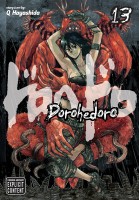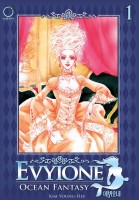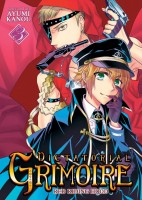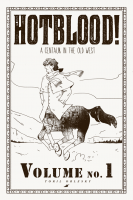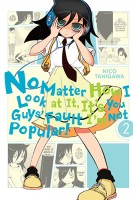My News and Reviews
Well, I didn’t manage to post my in-depth manga review for April last week after all. Today I’m starting in a new position at a different library, meaning that last week I spent most of my time tying up as many loose ends as possible at my previous job. This included writing a lot of documentation. And since I was doing so much writing for work, by the time I got home I didn’t want to do anything but read, so that’s what I did. (Which goes to explain why I ended up finishing Cixin Liu’s excellent novel The Three-Body Problem much sooner than I had originally anticipated.) But never fear, I’ll be posting my review of Nagabe’s The Girl from the Other Side later this week in addition to the monthly manga giveaway.
In other news, Seven Seas continued its string of licensing announcements, adding Orikō Yoshino and Z-ton’s light novel series Monster Girl Doctor, Kazuki Funatsu’s Yokai Girls manga, and Saki Hasemi and Kentaro Yabuki’s To Love Ru and To Love Ru Darkness manga to the slate. Recent announcements from Viz Media included Sankichi Hinodeya’s Splatoon manga, a Hello Kitty coloring book, picture books of Hayao Miyazaki’s Castle in the Sky and Princess Mononoke, as well as the My Little Pony: The Movie artbook. Kodansha Comics had a couple of announcements to make recently, too, such as the upcoming release of full-color hardcover edition of Gun Snark’s Attack on Titan: No Regrets (I’ve previously reviewed the series’ first English-language release) and a hardcover omnibus edition of Yukito Kishiro’s Battle Angel Alita. (The series was originally published in English by Viz Media but has been out-of-print for quite some time.)
I also came across a few other interesting things last week: Over at The OASG, Justin interviewed Mariko Hihara and Kotoyo Noguchi, two independent manga creators in Japan. Noguchi also had some questions to ask in return. Frederik L. Schodt (whose work I greatly enjoy) was recently profiled at Nippon.com. The article takes a look at his involvement as an ambassador for manga over the last four decades. Caitlin from I Have a Heroine Problem presented a panel called “Is This Feminist or Not? Ways of Talking about Women in Anime” at Sakura Con 2017 and has made her slides available. A very nicely designed site called Persona Problems offers criticism of Persona 5‘s English localization and delves into translation theory and practice that even people who don’t play the game may find interesting. Finally, the author and designer Iku Okada has started a series of autobiographical essays called Otaku Girl and Proud which explores Japanese gender inequality and identity and how popular culture can impact that experience.
Quick Takes
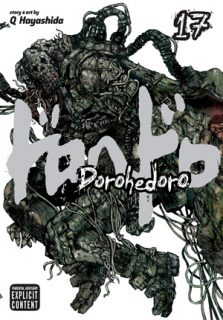 Dorohedoro, Volumes 17-20 by Q Hayashida. Despite being one of my favorite ongoing series currently being released in English, I seem to somehow always forget how incredibly much I love Dorohedoro. I tend to forget how tremendously horrific the manga can be, too, mostly because it simultaneously manages to be surprisingly endearing. Hayashida’s story and artwork is frequently and stunningly brutal, gut-churning, and grotesque, but Dorohedoro also carries with it a great sense of humor. Granted, the comedy in Dorohedoro tends to be phenomenally dark. Lately, as Dorohedoro continues to steadily progress along what I believe will be it’s final major story arc, the series has become fairly intense and serious, but it remains exceptionally weird and has yet to completely lose its humor. The plot of Dorohedoro does meander a bit and because it’s been so long since I’ve read the previous volumes I’m sure that I’ve forgotten a few important details as the story takes multiple convoluted turns along the way. Ultimately, it doesn’t seem to really matter though since the world and characters of of Dorohedoro follow and operate under their own peculiar sort of logic; Dorohedoro doesn’t need to make a lot of sense in order to be bizarrely enjoyable.
Dorohedoro, Volumes 17-20 by Q Hayashida. Despite being one of my favorite ongoing series currently being released in English, I seem to somehow always forget how incredibly much I love Dorohedoro. I tend to forget how tremendously horrific the manga can be, too, mostly because it simultaneously manages to be surprisingly endearing. Hayashida’s story and artwork is frequently and stunningly brutal, gut-churning, and grotesque, but Dorohedoro also carries with it a great sense of humor. Granted, the comedy in Dorohedoro tends to be phenomenally dark. Lately, as Dorohedoro continues to steadily progress along what I believe will be it’s final major story arc, the series has become fairly intense and serious, but it remains exceptionally weird and has yet to completely lose its humor. The plot of Dorohedoro does meander a bit and because it’s been so long since I’ve read the previous volumes I’m sure that I’ve forgotten a few important details as the story takes multiple convoluted turns along the way. Ultimately, it doesn’t seem to really matter though since the world and characters of of Dorohedoro follow and operate under their own peculiar sort of logic; Dorohedoro doesn’t need to make a lot of sense in order to be bizarrely enjoyable.
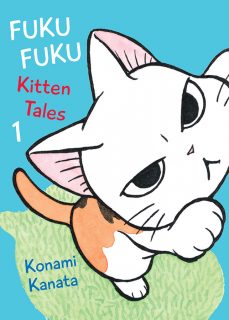 FukuFuku: Kitten Tales, Volumes 1-2 by Kanata Konami. Before there was Chi’s Sweet Home there was FukuFuku Funyan, Konami’s cat manga which started in the late 1980s. The series featured an elderly woman and her cat FukuFuku. More recently, Konami created FukuFuku: Kitten Tales, a spinoff of FukuFuku’s first series which, as can be accurately assumed by the manga’s title, shares stories from the loveable feline’s youth. While Konami’s artwork in FukuFuku: Kitten Tales is black-and-white rather than being full-color and the manga is only two-volumes long rather than being twelve, the series is otherwise very similar in format to Chi’s Sweet Home. It’s actually been quite a while since I’ve read any of Chi’s Sweet Home, but FukuFuku: Kitten Tales feels like it might be a little more episodic as well. However, it is still an incredibly cute series. Each chapter is only six pages or so but manages to tell a complete story, accurately portraying the everyday life and antics of a kitten. FukuFuku: Kitten Tales isn’t especially compelling or creative as far as cat manga goes, but it is an adorable series which consistently made me smile and even chuckle from time to time.
FukuFuku: Kitten Tales, Volumes 1-2 by Kanata Konami. Before there was Chi’s Sweet Home there was FukuFuku Funyan, Konami’s cat manga which started in the late 1980s. The series featured an elderly woman and her cat FukuFuku. More recently, Konami created FukuFuku: Kitten Tales, a spinoff of FukuFuku’s first series which, as can be accurately assumed by the manga’s title, shares stories from the loveable feline’s youth. While Konami’s artwork in FukuFuku: Kitten Tales is black-and-white rather than being full-color and the manga is only two-volumes long rather than being twelve, the series is otherwise very similar in format to Chi’s Sweet Home. It’s actually been quite a while since I’ve read any of Chi’s Sweet Home, but FukuFuku: Kitten Tales feels like it might be a little more episodic as well. However, it is still an incredibly cute series. Each chapter is only six pages or so but manages to tell a complete story, accurately portraying the everyday life and antics of a kitten. FukuFuku: Kitten Tales isn’t especially compelling or creative as far as cat manga goes, but it is an adorable series which consistently made me smile and even chuckle from time to time.
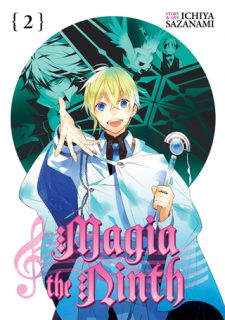 Magia the Ninth, Volume 2 by Ichiya Sazanami. I enjoyed the first volume of Magia the Ninth immensely. I’m not really sure I could call it a good manga per se, and I don’t think I would necessarily recommend it broadly, but personally I got a huge kick out of it. That being said, I can’t say that I’m surprised that the series only lasted two volumes. (I don’t know for certain, but I get the feeling that Magia the Ninth was cancelled.) What did surprise me was how well Sazanami was able to pull everything together to conclude the manga in a coherent (and almost satisfying) fashion when obviously it was intended to be a series on a much grander scale. To be honest, Magia the Ninth probably would have done much better for itself if the manga had had that level of focus from the very beginning. Magia the Ninth is a strange and somewhat goofy little series about demons, magic, and music. While the series wasn’t always the most comprehensible, it’s stylishly drawn, has tremendous energy, and even manages to effectively incorporate legitimate music history into the story. Magia the Ninth may not have lived up to its potential, but I had fun with it.
Magia the Ninth, Volume 2 by Ichiya Sazanami. I enjoyed the first volume of Magia the Ninth immensely. I’m not really sure I could call it a good manga per se, and I don’t think I would necessarily recommend it broadly, but personally I got a huge kick out of it. That being said, I can’t say that I’m surprised that the series only lasted two volumes. (I don’t know for certain, but I get the feeling that Magia the Ninth was cancelled.) What did surprise me was how well Sazanami was able to pull everything together to conclude the manga in a coherent (and almost satisfying) fashion when obviously it was intended to be a series on a much grander scale. To be honest, Magia the Ninth probably would have done much better for itself if the manga had had that level of focus from the very beginning. Magia the Ninth is a strange and somewhat goofy little series about demons, magic, and music. While the series wasn’t always the most comprehensible, it’s stylishly drawn, has tremendous energy, and even manages to effectively incorporate legitimate music history into the story. Magia the Ninth may not have lived up to its potential, but I had fun with it.
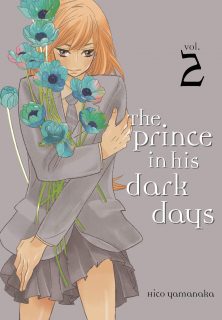 The Prince in His Dark Days, Volumes 2-3 by Hico Yamanaka. More and more of The Prince in His Dark Days seems to revolve around Itaru, but at this point I would still consider Atsuko, who is serving as Itaru’s double, to be the real lead of the manga. Unfortunately, Atsuko is casually threatened with sexual violence on a regular basis in the series which frankly makes me uncomfortable. In general, the power dynamics in The Prince in His Dark Days tend to be fairly disconcerting. It doesn’t really help when other characters’ try to play it off as a joke, either. If anything, it only seems to emphasize the fact that so many of them are unrepentant jerks. I know that I’m supposed to empathize with some of their personal struggles, but I find it difficult to spare a lot of sympathy for entitled assholes. However, the themes that Yamanaka explores in The Prince in His Dark Days are of tremendous interest to me, most notably those of gender expression and sexual identity. I also appreciate the manga’s melancholy mood and the slow blossoming of love in unexpected places. There’s only one volume left in The Prince in His Dark Days and despite some of my reservations about the series I am curious to see how it ends.
The Prince in His Dark Days, Volumes 2-3 by Hico Yamanaka. More and more of The Prince in His Dark Days seems to revolve around Itaru, but at this point I would still consider Atsuko, who is serving as Itaru’s double, to be the real lead of the manga. Unfortunately, Atsuko is casually threatened with sexual violence on a regular basis in the series which frankly makes me uncomfortable. In general, the power dynamics in The Prince in His Dark Days tend to be fairly disconcerting. It doesn’t really help when other characters’ try to play it off as a joke, either. If anything, it only seems to emphasize the fact that so many of them are unrepentant jerks. I know that I’m supposed to empathize with some of their personal struggles, but I find it difficult to spare a lot of sympathy for entitled assholes. However, the themes that Yamanaka explores in The Prince in His Dark Days are of tremendous interest to me, most notably those of gender expression and sexual identity. I also appreciate the manga’s melancholy mood and the slow blossoming of love in unexpected places. There’s only one volume left in The Prince in His Dark Days and despite some of my reservations about the series I am curious to see how it ends.
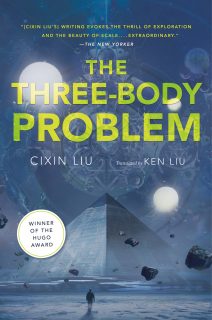 The Three-Body Problem by Cixin Liu. If my memory serves me right, The Three-Body Problem is actually the first contemporary Chinese novel that I’ve read. It initially came to my attention when it became the first work in translation to win the Hugo Award for Best Novel. Interestingly, when The Three-Body Problem was translated into English by Ken Liu, the order of the chapters was restored to what the author originally intended and a few additional changes were made in consideration of some of the real-world scientific advances that had developed since the novel was first published in China. As a novel that leans heavily on hard science, I found The Three-Body Problem to be fascinating. (At one point in my life, I actually considered going into theoretical physics.) But what makes The Three-Body Problem so compelling are the social aspects of the narrative. In particular, China’s Cultural Revolution and the characters’ responses to it play a critical role in the story’s development. The Three-Body Problem is the first book in a trilogy, Remembrance of Earth’s Past, and so while largely being a satisfying novel on its own, it’s obviously only the beginning of a larger work. I definitely plan on reading the rest.
The Three-Body Problem by Cixin Liu. If my memory serves me right, The Three-Body Problem is actually the first contemporary Chinese novel that I’ve read. It initially came to my attention when it became the first work in translation to win the Hugo Award for Best Novel. Interestingly, when The Three-Body Problem was translated into English by Ken Liu, the order of the chapters was restored to what the author originally intended and a few additional changes were made in consideration of some of the real-world scientific advances that had developed since the novel was first published in China. As a novel that leans heavily on hard science, I found The Three-Body Problem to be fascinating. (At one point in my life, I actually considered going into theoretical physics.) But what makes The Three-Body Problem so compelling are the social aspects of the narrative. In particular, China’s Cultural Revolution and the characters’ responses to it play a critical role in the story’s development. The Three-Body Problem is the first book in a trilogy, Remembrance of Earth’s Past, and so while largely being a satisfying novel on its own, it’s obviously only the beginning of a larger work. I definitely plan on reading the rest.
